Indigenous Rights: An Analysis of the UN Declaration and its Influence
VerifiedAdded on 2023/06/07
|9
|2108
|230
Essay
AI Summary
This essay provides a comprehensive analysis of the United Nations Declaration on the Rights of Indigenous Peoples (UNDRIP). It examines the historical context of the declaration, its drafting process, and its significance in recognizing and protecting the rights of indigenous communities. The essay highlights the dichotomy between individual human rights and state sovereignty, emphasizing the declaration's support for collective human rights and self-determination. It discusses the impact of UNDRIP in addressing issues related to indigenous and tribal groups, including the role of the International Labor Organization (ILO) and the establishment of various mechanisms for promoting indigenous rights. Furthermore, the essay explores the ways in which UNDRIP addresses obstacles to human rights protection, promotes best practices, and encourages negotiations between states and indigenous communities. The essay also emphasizes the importance of preserving indigenous culture and identity, concluding with a summary of the rights guaranteed to indigenous peoples, such as the right to practice cultural customs, control education, and develop traditional structures, all aimed at preserving their heritage and knowledge.

Running head: INDIGENOUS RIGHTS
Indigenous Rights
Name of the Student
Name of the University
Author Note
Indigenous Rights
Name of the Student
Name of the University
Author Note
Paraphrase This Document
Need a fresh take? Get an instant paraphrase of this document with our AI Paraphraser
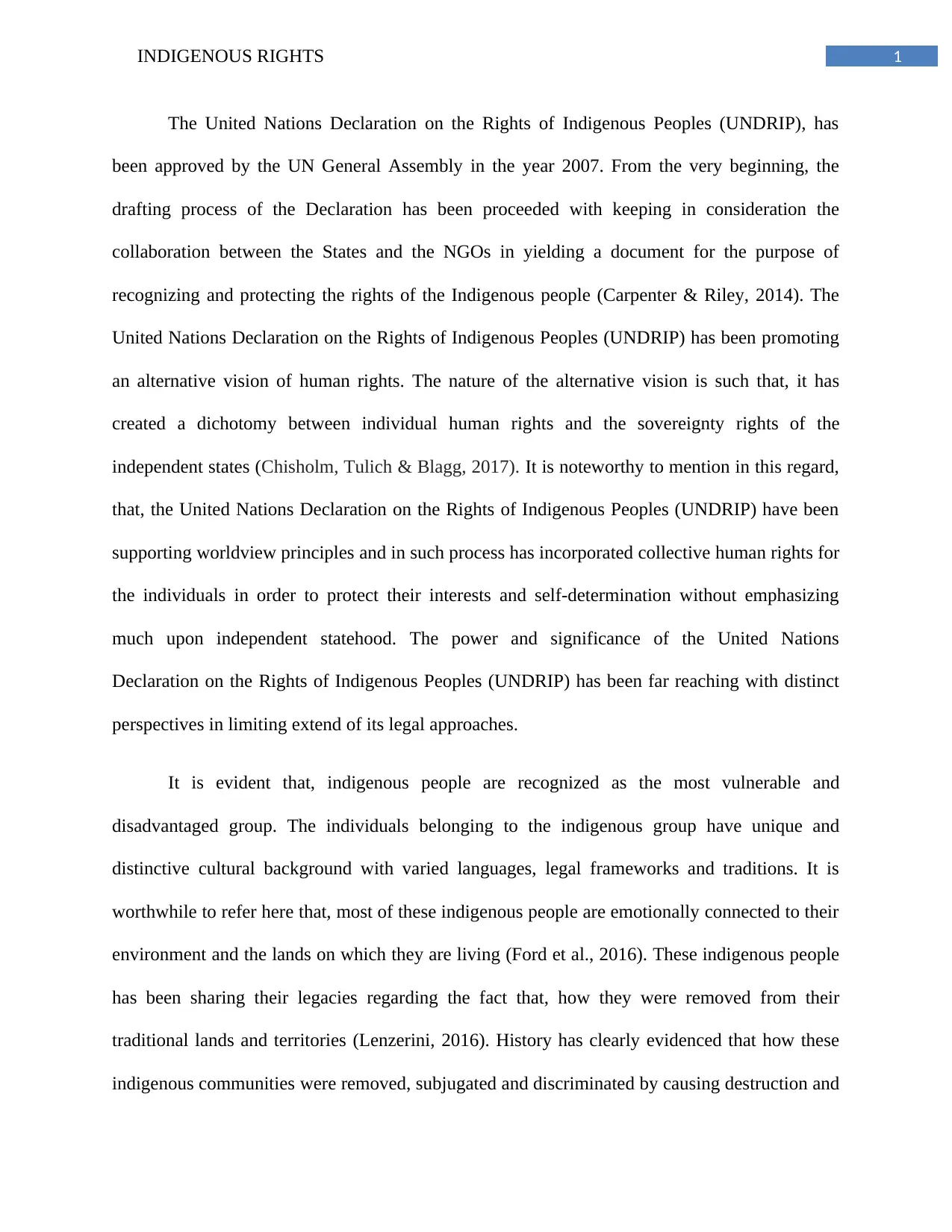
1INDIGENOUS RIGHTS
The United Nations Declaration on the Rights of Indigenous Peoples (UNDRIP), has
been approved by the UN General Assembly in the year 2007. From the very beginning, the
drafting process of the Declaration has been proceeded with keeping in consideration the
collaboration between the States and the NGOs in yielding a document for the purpose of
recognizing and protecting the rights of the Indigenous people (Carpenter & Riley, 2014). The
United Nations Declaration on the Rights of Indigenous Peoples (UNDRIP) has been promoting
an alternative vision of human rights. The nature of the alternative vision is such that, it has
created a dichotomy between individual human rights and the sovereignty rights of the
independent states (Chisholm, Tulich & Blagg, 2017). It is noteworthy to mention in this regard,
that, the United Nations Declaration on the Rights of Indigenous Peoples (UNDRIP) have been
supporting worldview principles and in such process has incorporated collective human rights for
the individuals in order to protect their interests and self-determination without emphasizing
much upon independent statehood. The power and significance of the United Nations
Declaration on the Rights of Indigenous Peoples (UNDRIP) has been far reaching with distinct
perspectives in limiting extend of its legal approaches.
It is evident that, indigenous people are recognized as the most vulnerable and
disadvantaged group. The individuals belonging to the indigenous group have unique and
distinctive cultural background with varied languages, legal frameworks and traditions. It is
worthwhile to refer here that, most of these indigenous people are emotionally connected to their
environment and the lands on which they are living (Ford et al., 2016). These indigenous people
has been sharing their legacies regarding the fact that, how they were removed from their
traditional lands and territories (Lenzerini, 2016). History has clearly evidenced that how these
indigenous communities were removed, subjugated and discriminated by causing destruction and
The United Nations Declaration on the Rights of Indigenous Peoples (UNDRIP), has
been approved by the UN General Assembly in the year 2007. From the very beginning, the
drafting process of the Declaration has been proceeded with keeping in consideration the
collaboration between the States and the NGOs in yielding a document for the purpose of
recognizing and protecting the rights of the Indigenous people (Carpenter & Riley, 2014). The
United Nations Declaration on the Rights of Indigenous Peoples (UNDRIP) has been promoting
an alternative vision of human rights. The nature of the alternative vision is such that, it has
created a dichotomy between individual human rights and the sovereignty rights of the
independent states (Chisholm, Tulich & Blagg, 2017). It is noteworthy to mention in this regard,
that, the United Nations Declaration on the Rights of Indigenous Peoples (UNDRIP) have been
supporting worldview principles and in such process has incorporated collective human rights for
the individuals in order to protect their interests and self-determination without emphasizing
much upon independent statehood. The power and significance of the United Nations
Declaration on the Rights of Indigenous Peoples (UNDRIP) has been far reaching with distinct
perspectives in limiting extend of its legal approaches.
It is evident that, indigenous people are recognized as the most vulnerable and
disadvantaged group. The individuals belonging to the indigenous group have unique and
distinctive cultural background with varied languages, legal frameworks and traditions. It is
worthwhile to refer here that, most of these indigenous people are emotionally connected to their
environment and the lands on which they are living (Ford et al., 2016). These indigenous people
has been sharing their legacies regarding the fact that, how they were removed from their
traditional lands and territories (Lenzerini, 2016). History has clearly evidenced that how these
indigenous communities were removed, subjugated and discriminated by causing destruction and

2INDIGENOUS RIGHTS
violation to their traditional territories. Throughout the centuries, the people belonging to the
indigenous communities have suffered as a result of non-recognition of their political and
cultural institutions. The integrity of their cultural background has been undermined under
various circumstances (Lenzerini, 2017). It is worth mentioning that, as a result of these ongoing
processes, it created unfavorable impact upon the developmental patterns of the indigenous
communities which posed as a grave threat to their political and cultural existence.
In response to the violation of human rights, indigenous people and their organization;
the United Nations Declaration on the Rights of Indigenous Peoples (UNDRIP) have addressed
these underlying issues in both domestic and international spheres. As a result of constant
intervention on the part of the United Nations Declaration on the Rights of Indigenous Peoples
(UNDRIP) in protecting the indigenous rights of the First Nations people is of utmost
significance (MacMillan, MacMillan & Rigney, 2016). This is due to the reason that, as a result
of such intervention, the indigenous communities have gained social and political visibility and
could argue their statements in both national and international forums. The United Nations
Declaration on the Rights of Indigenous Peoples (UNDRIP) for the purpose of addressing the
issues regarding indigenous and tribal groups has established the International Labor
Organization (ILO) which later on gained international cooperation and recognition (Nagel,
Johnson & Hall, 2015). The International Labor Organization (ILO) has been in existence and
operated efficiently for the purpose of protecting and promoting the rights of the indigenous
communities since the beginning of the 1920s. It is worthwhile to mention here that the,
International Labor Organization (ILO) has formulated two distinct international instruments in
regard to the protection of the interests of the indigenous people categorized as- the Indigenous
violation to their traditional territories. Throughout the centuries, the people belonging to the
indigenous communities have suffered as a result of non-recognition of their political and
cultural institutions. The integrity of their cultural background has been undermined under
various circumstances (Lenzerini, 2017). It is worth mentioning that, as a result of these ongoing
processes, it created unfavorable impact upon the developmental patterns of the indigenous
communities which posed as a grave threat to their political and cultural existence.
In response to the violation of human rights, indigenous people and their organization;
the United Nations Declaration on the Rights of Indigenous Peoples (UNDRIP) have addressed
these underlying issues in both domestic and international spheres. As a result of constant
intervention on the part of the United Nations Declaration on the Rights of Indigenous Peoples
(UNDRIP) in protecting the indigenous rights of the First Nations people is of utmost
significance (MacMillan, MacMillan & Rigney, 2016). This is due to the reason that, as a result
of such intervention, the indigenous communities have gained social and political visibility and
could argue their statements in both national and international forums. The United Nations
Declaration on the Rights of Indigenous Peoples (UNDRIP) for the purpose of addressing the
issues regarding indigenous and tribal groups has established the International Labor
Organization (ILO) which later on gained international cooperation and recognition (Nagel,
Johnson & Hall, 2015). The International Labor Organization (ILO) has been in existence and
operated efficiently for the purpose of protecting and promoting the rights of the indigenous
communities since the beginning of the 1920s. It is worthwhile to mention here that the,
International Labor Organization (ILO) has formulated two distinct international instruments in
regard to the protection of the interests of the indigenous people categorized as- the Indigenous
⊘ This is a preview!⊘
Do you want full access?
Subscribe today to unlock all pages.

Trusted by 1+ million students worldwide
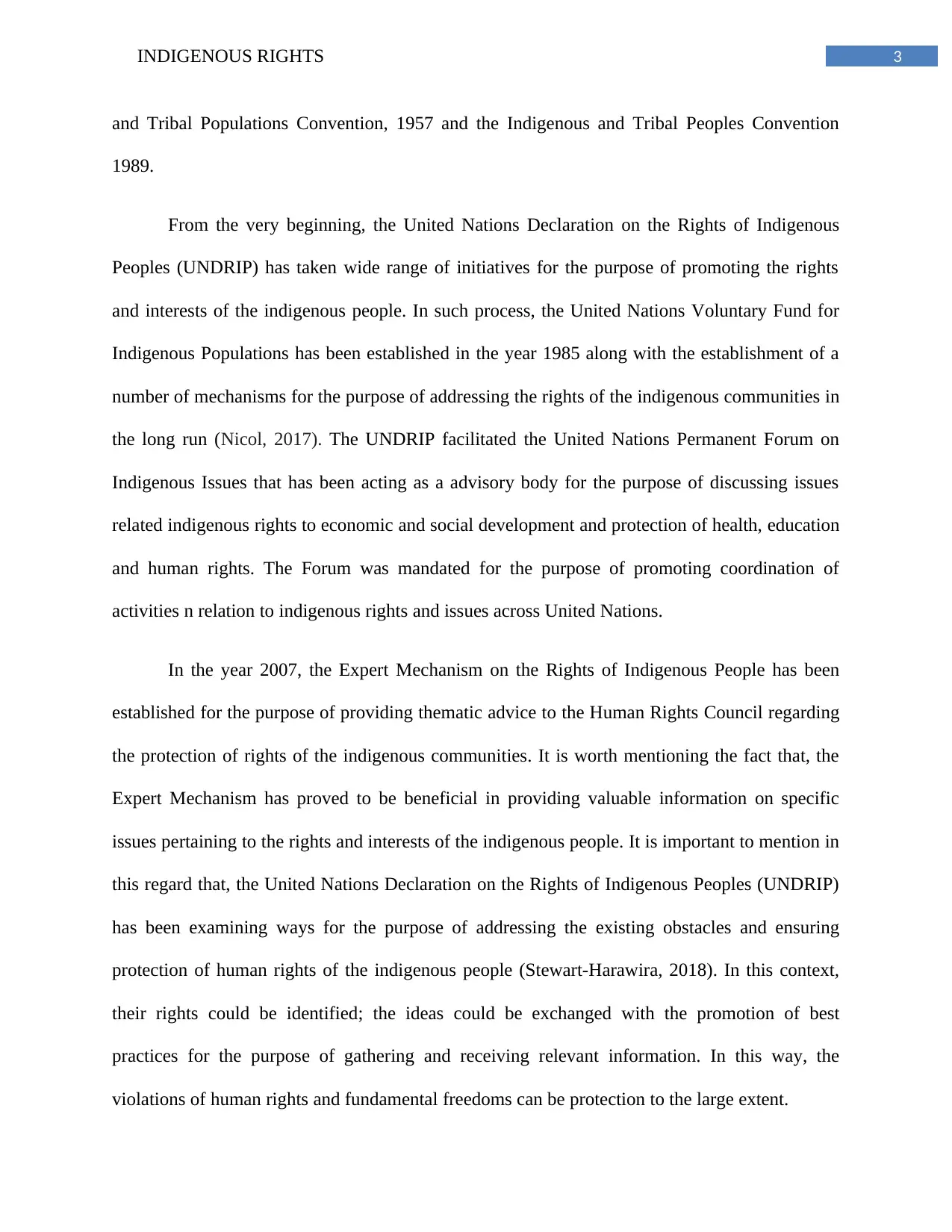
3INDIGENOUS RIGHTS
and Tribal Populations Convention, 1957 and the Indigenous and Tribal Peoples Convention
1989.
From the very beginning, the United Nations Declaration on the Rights of Indigenous
Peoples (UNDRIP) has taken wide range of initiatives for the purpose of promoting the rights
and interests of the indigenous people. In such process, the United Nations Voluntary Fund for
Indigenous Populations has been established in the year 1985 along with the establishment of a
number of mechanisms for the purpose of addressing the rights of the indigenous communities in
the long run (Nicol, 2017). The UNDRIP facilitated the United Nations Permanent Forum on
Indigenous Issues that has been acting as a advisory body for the purpose of discussing issues
related indigenous rights to economic and social development and protection of health, education
and human rights. The Forum was mandated for the purpose of promoting coordination of
activities n relation to indigenous rights and issues across United Nations.
In the year 2007, the Expert Mechanism on the Rights of Indigenous People has been
established for the purpose of providing thematic advice to the Human Rights Council regarding
the protection of rights of the indigenous communities. It is worth mentioning the fact that, the
Expert Mechanism has proved to be beneficial in providing valuable information on specific
issues pertaining to the rights and interests of the indigenous people. It is important to mention in
this regard that, the United Nations Declaration on the Rights of Indigenous Peoples (UNDRIP)
has been examining ways for the purpose of addressing the existing obstacles and ensuring
protection of human rights of the indigenous people (Stewart-Harawira, 2018). In this context,
their rights could be identified; the ideas could be exchanged with the promotion of best
practices for the purpose of gathering and receiving relevant information. In this way, the
violations of human rights and fundamental freedoms can be protection to the large extent.
and Tribal Populations Convention, 1957 and the Indigenous and Tribal Peoples Convention
1989.
From the very beginning, the United Nations Declaration on the Rights of Indigenous
Peoples (UNDRIP) has taken wide range of initiatives for the purpose of promoting the rights
and interests of the indigenous people. In such process, the United Nations Voluntary Fund for
Indigenous Populations has been established in the year 1985 along with the establishment of a
number of mechanisms for the purpose of addressing the rights of the indigenous communities in
the long run (Nicol, 2017). The UNDRIP facilitated the United Nations Permanent Forum on
Indigenous Issues that has been acting as a advisory body for the purpose of discussing issues
related indigenous rights to economic and social development and protection of health, education
and human rights. The Forum was mandated for the purpose of promoting coordination of
activities n relation to indigenous rights and issues across United Nations.
In the year 2007, the Expert Mechanism on the Rights of Indigenous People has been
established for the purpose of providing thematic advice to the Human Rights Council regarding
the protection of rights of the indigenous communities. It is worth mentioning the fact that, the
Expert Mechanism has proved to be beneficial in providing valuable information on specific
issues pertaining to the rights and interests of the indigenous people. It is important to mention in
this regard that, the United Nations Declaration on the Rights of Indigenous Peoples (UNDRIP)
has been examining ways for the purpose of addressing the existing obstacles and ensuring
protection of human rights of the indigenous people (Stewart-Harawira, 2018). In this context,
their rights could be identified; the ideas could be exchanged with the promotion of best
practices for the purpose of gathering and receiving relevant information. In this way, the
violations of human rights and fundamental freedoms can be protection to the large extent.
Paraphrase This Document
Need a fresh take? Get an instant paraphrase of this document with our AI Paraphraser
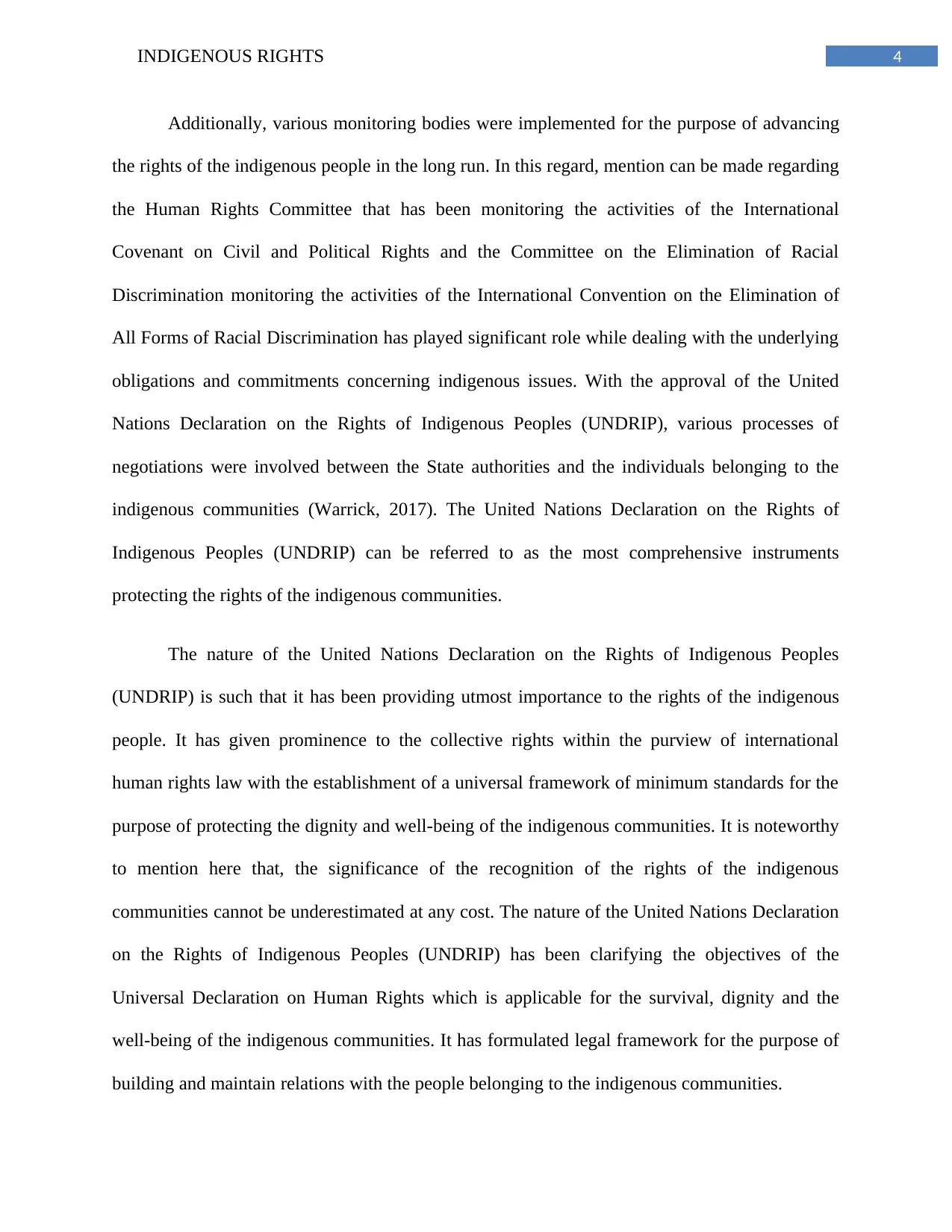
4INDIGENOUS RIGHTS
Additionally, various monitoring bodies were implemented for the purpose of advancing
the rights of the indigenous people in the long run. In this regard, mention can be made regarding
the Human Rights Committee that has been monitoring the activities of the International
Covenant on Civil and Political Rights and the Committee on the Elimination of Racial
Discrimination monitoring the activities of the International Convention on the Elimination of
All Forms of Racial Discrimination has played significant role while dealing with the underlying
obligations and commitments concerning indigenous issues. With the approval of the United
Nations Declaration on the Rights of Indigenous Peoples (UNDRIP), various processes of
negotiations were involved between the State authorities and the individuals belonging to the
indigenous communities (Warrick, 2017). The United Nations Declaration on the Rights of
Indigenous Peoples (UNDRIP) can be referred to as the most comprehensive instruments
protecting the rights of the indigenous communities.
The nature of the United Nations Declaration on the Rights of Indigenous Peoples
(UNDRIP) is such that it has been providing utmost importance to the rights of the indigenous
people. It has given prominence to the collective rights within the purview of international
human rights law with the establishment of a universal framework of minimum standards for the
purpose of protecting the dignity and well-being of the indigenous communities. It is noteworthy
to mention here that, the significance of the recognition of the rights of the indigenous
communities cannot be underestimated at any cost. The nature of the United Nations Declaration
on the Rights of Indigenous Peoples (UNDRIP) has been clarifying the objectives of the
Universal Declaration on Human Rights which is applicable for the survival, dignity and the
well-being of the indigenous communities. It has formulated legal framework for the purpose of
building and maintain relations with the people belonging to the indigenous communities.
Additionally, various monitoring bodies were implemented for the purpose of advancing
the rights of the indigenous people in the long run. In this regard, mention can be made regarding
the Human Rights Committee that has been monitoring the activities of the International
Covenant on Civil and Political Rights and the Committee on the Elimination of Racial
Discrimination monitoring the activities of the International Convention on the Elimination of
All Forms of Racial Discrimination has played significant role while dealing with the underlying
obligations and commitments concerning indigenous issues. With the approval of the United
Nations Declaration on the Rights of Indigenous Peoples (UNDRIP), various processes of
negotiations were involved between the State authorities and the individuals belonging to the
indigenous communities (Warrick, 2017). The United Nations Declaration on the Rights of
Indigenous Peoples (UNDRIP) can be referred to as the most comprehensive instruments
protecting the rights of the indigenous communities.
The nature of the United Nations Declaration on the Rights of Indigenous Peoples
(UNDRIP) is such that it has been providing utmost importance to the rights of the indigenous
people. It has given prominence to the collective rights within the purview of international
human rights law with the establishment of a universal framework of minimum standards for the
purpose of protecting the dignity and well-being of the indigenous communities. It is noteworthy
to mention here that, the significance of the recognition of the rights of the indigenous
communities cannot be underestimated at any cost. The nature of the United Nations Declaration
on the Rights of Indigenous Peoples (UNDRIP) has been clarifying the objectives of the
Universal Declaration on Human Rights which is applicable for the survival, dignity and the
well-being of the indigenous communities. It has formulated legal framework for the purpose of
building and maintain relations with the people belonging to the indigenous communities.
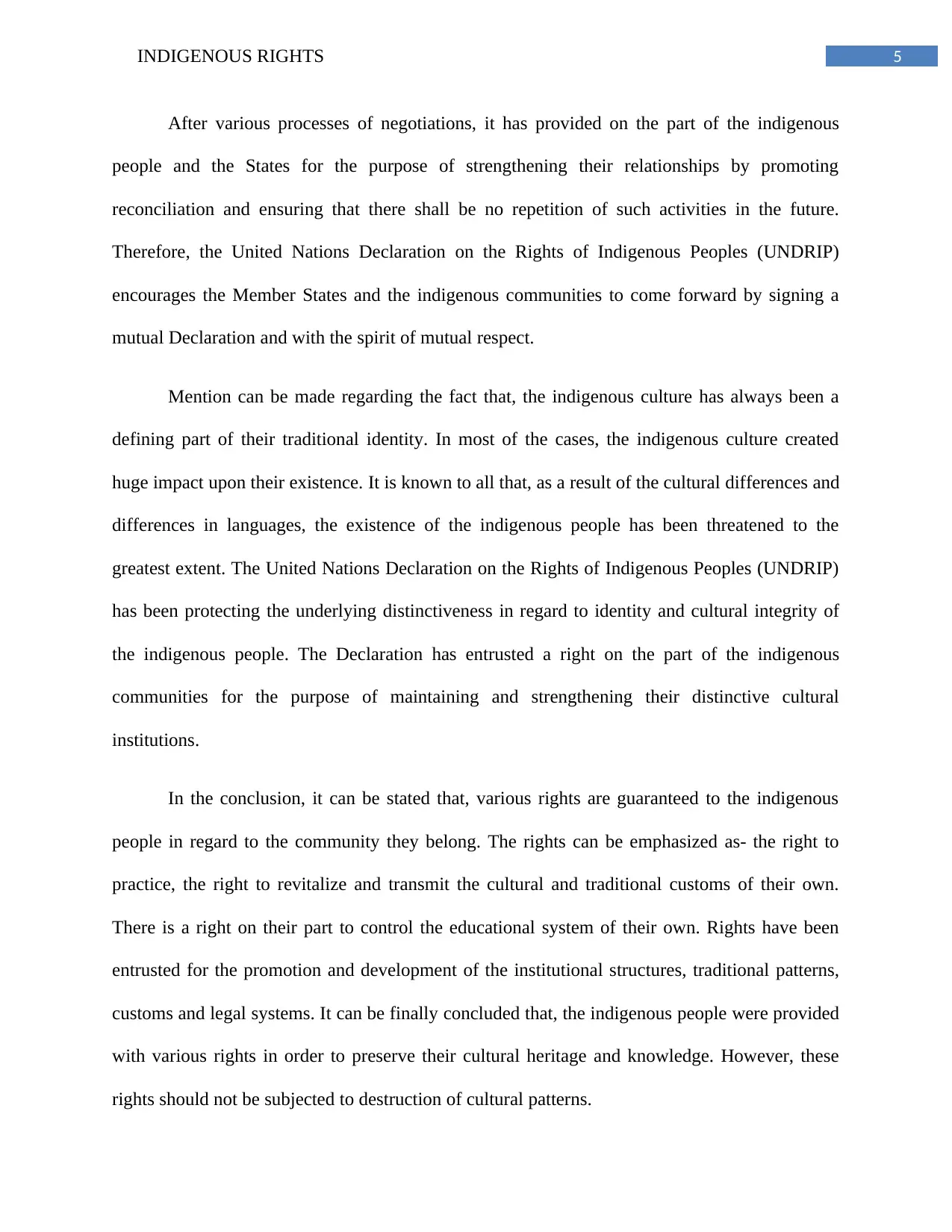
5INDIGENOUS RIGHTS
After various processes of negotiations, it has provided on the part of the indigenous
people and the States for the purpose of strengthening their relationships by promoting
reconciliation and ensuring that there shall be no repetition of such activities in the future.
Therefore, the United Nations Declaration on the Rights of Indigenous Peoples (UNDRIP)
encourages the Member States and the indigenous communities to come forward by signing a
mutual Declaration and with the spirit of mutual respect.
Mention can be made regarding the fact that, the indigenous culture has always been a
defining part of their traditional identity. In most of the cases, the indigenous culture created
huge impact upon their existence. It is known to all that, as a result of the cultural differences and
differences in languages, the existence of the indigenous people has been threatened to the
greatest extent. The United Nations Declaration on the Rights of Indigenous Peoples (UNDRIP)
has been protecting the underlying distinctiveness in regard to identity and cultural integrity of
the indigenous people. The Declaration has entrusted a right on the part of the indigenous
communities for the purpose of maintaining and strengthening their distinctive cultural
institutions.
In the conclusion, it can be stated that, various rights are guaranteed to the indigenous
people in regard to the community they belong. The rights can be emphasized as- the right to
practice, the right to revitalize and transmit the cultural and traditional customs of their own.
There is a right on their part to control the educational system of their own. Rights have been
entrusted for the promotion and development of the institutional structures, traditional patterns,
customs and legal systems. It can be finally concluded that, the indigenous people were provided
with various rights in order to preserve their cultural heritage and knowledge. However, these
rights should not be subjected to destruction of cultural patterns.
After various processes of negotiations, it has provided on the part of the indigenous
people and the States for the purpose of strengthening their relationships by promoting
reconciliation and ensuring that there shall be no repetition of such activities in the future.
Therefore, the United Nations Declaration on the Rights of Indigenous Peoples (UNDRIP)
encourages the Member States and the indigenous communities to come forward by signing a
mutual Declaration and with the spirit of mutual respect.
Mention can be made regarding the fact that, the indigenous culture has always been a
defining part of their traditional identity. In most of the cases, the indigenous culture created
huge impact upon their existence. It is known to all that, as a result of the cultural differences and
differences in languages, the existence of the indigenous people has been threatened to the
greatest extent. The United Nations Declaration on the Rights of Indigenous Peoples (UNDRIP)
has been protecting the underlying distinctiveness in regard to identity and cultural integrity of
the indigenous people. The Declaration has entrusted a right on the part of the indigenous
communities for the purpose of maintaining and strengthening their distinctive cultural
institutions.
In the conclusion, it can be stated that, various rights are guaranteed to the indigenous
people in regard to the community they belong. The rights can be emphasized as- the right to
practice, the right to revitalize and transmit the cultural and traditional customs of their own.
There is a right on their part to control the educational system of their own. Rights have been
entrusted for the promotion and development of the institutional structures, traditional patterns,
customs and legal systems. It can be finally concluded that, the indigenous people were provided
with various rights in order to preserve their cultural heritage and knowledge. However, these
rights should not be subjected to destruction of cultural patterns.
⊘ This is a preview!⊘
Do you want full access?
Subscribe today to unlock all pages.

Trusted by 1+ million students worldwide

6INDIGENOUS RIGHTS
Paraphrase This Document
Need a fresh take? Get an instant paraphrase of this document with our AI Paraphraser

7INDIGENOUS RIGHTS
References:
Carpenter, K. A., & Riley, A. R. (2014). Indigenous peoples and the jurisgenerative moment in
human rights. Cal. L. Rev., 102, 173.
Chisholm, R., Tulich, T., & Blagg, H. (2017). Indigenous young people with foetal alcohol
spectrum disorders: The convention on the rights of persons with disabilities and reform
to the law governing fitness to stand trial in Western Australia. Law in Context, 35(2), 85.
Ford, J., Maillet, M., Pouliot, V., Meredith, T., Cavanaugh, A., & IHACC Research Team.
(2016). Adaptation and indigenous peoples in the United Nations framework.
Lenzerini, F. (2016). Cultural Identity, Human Rights, and Repatriation of Cultural Heritage of
Indigenous Peoples. Brown J. World Aff., 23, 127.
Lenzerini, F. (2017). 18. The land rights of indigenous peoples under international
law. Comparative Property Law: Global Perspectives, 393.
MacMillan, M., MacMillan, F., & Rigney, S. (2016). How Indigenous Nation-Building Can
Strengthen Indigenous Holistic Health Outcomes: Retelling the Right to Health. Journal
of Northern Studies, 10(2), 147-159.
Nagel, J., Johnson, J. T., & Hall, T. D. (2015). Indigenous Peoples. The Wiley Blackwell
Encyclopedia of Race, Ethnicity, and Nationalism, 1-6.
Nicol, H. N. (2017). From Territory to Rights: New Foundations for Conceptualising Indigenous
Sovereignty. Geopolitics, 22(4), 794-814. imate change. Climatic change, 139(3-4), 429-
443.
References:
Carpenter, K. A., & Riley, A. R. (2014). Indigenous peoples and the jurisgenerative moment in
human rights. Cal. L. Rev., 102, 173.
Chisholm, R., Tulich, T., & Blagg, H. (2017). Indigenous young people with foetal alcohol
spectrum disorders: The convention on the rights of persons with disabilities and reform
to the law governing fitness to stand trial in Western Australia. Law in Context, 35(2), 85.
Ford, J., Maillet, M., Pouliot, V., Meredith, T., Cavanaugh, A., & IHACC Research Team.
(2016). Adaptation and indigenous peoples in the United Nations framework.
Lenzerini, F. (2016). Cultural Identity, Human Rights, and Repatriation of Cultural Heritage of
Indigenous Peoples. Brown J. World Aff., 23, 127.
Lenzerini, F. (2017). 18. The land rights of indigenous peoples under international
law. Comparative Property Law: Global Perspectives, 393.
MacMillan, M., MacMillan, F., & Rigney, S. (2016). How Indigenous Nation-Building Can
Strengthen Indigenous Holistic Health Outcomes: Retelling the Right to Health. Journal
of Northern Studies, 10(2), 147-159.
Nagel, J., Johnson, J. T., & Hall, T. D. (2015). Indigenous Peoples. The Wiley Blackwell
Encyclopedia of Race, Ethnicity, and Nationalism, 1-6.
Nicol, H. N. (2017). From Territory to Rights: New Foundations for Conceptualising Indigenous
Sovereignty. Geopolitics, 22(4), 794-814. imate change. Climatic change, 139(3-4), 429-
443.
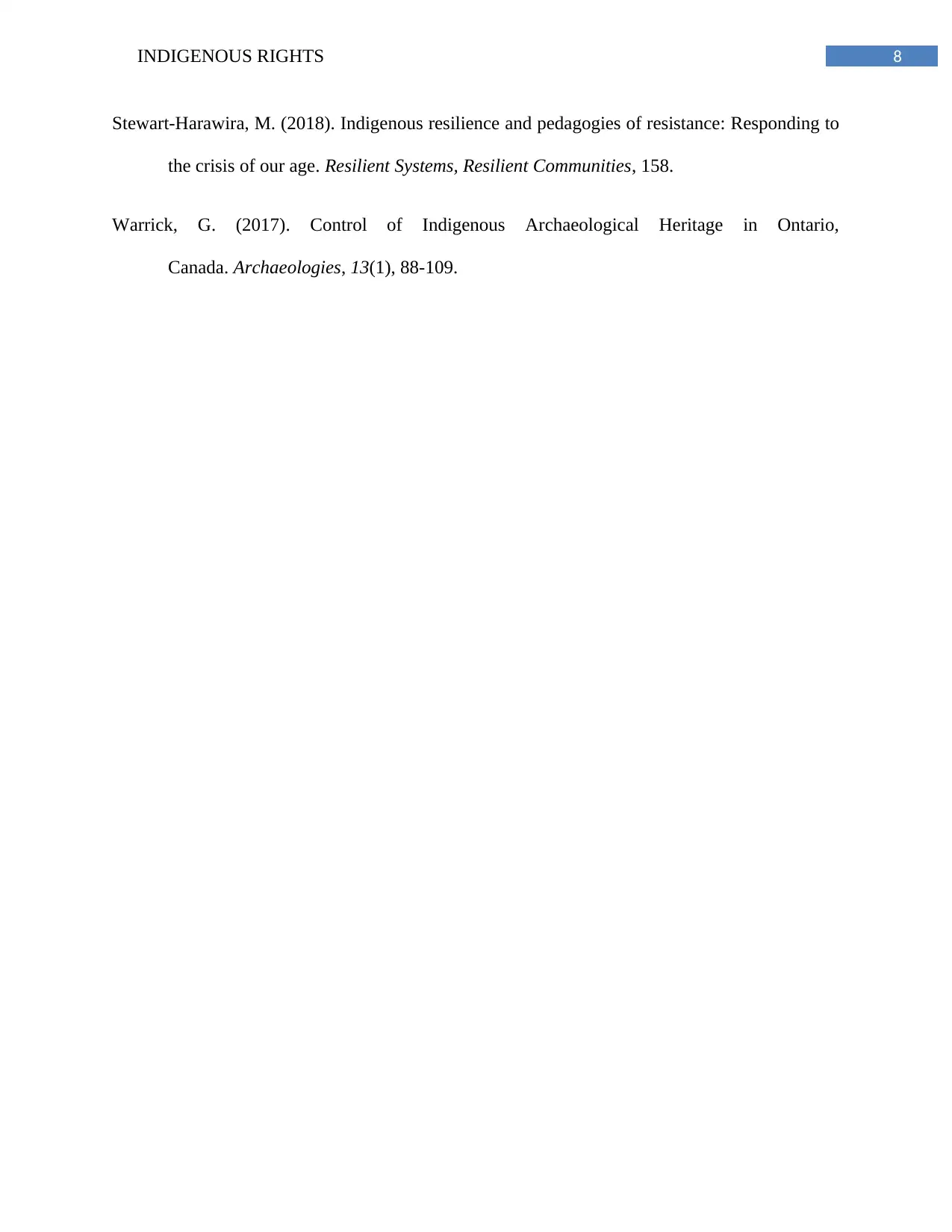
8INDIGENOUS RIGHTS
Stewart-Harawira, M. (2018). Indigenous resilience and pedagogies of resistance: Responding to
the crisis of our age. Resilient Systems, Resilient Communities, 158.
Warrick, G. (2017). Control of Indigenous Archaeological Heritage in Ontario,
Canada. Archaeologies, 13(1), 88-109.
Stewart-Harawira, M. (2018). Indigenous resilience and pedagogies of resistance: Responding to
the crisis of our age. Resilient Systems, Resilient Communities, 158.
Warrick, G. (2017). Control of Indigenous Archaeological Heritage in Ontario,
Canada. Archaeologies, 13(1), 88-109.
⊘ This is a preview!⊘
Do you want full access?
Subscribe today to unlock all pages.

Trusted by 1+ million students worldwide
1 out of 9
Related Documents
Your All-in-One AI-Powered Toolkit for Academic Success.
+13062052269
info@desklib.com
Available 24*7 on WhatsApp / Email
![[object Object]](/_next/static/media/star-bottom.7253800d.svg)
Unlock your academic potential
Copyright © 2020–2025 A2Z Services. All Rights Reserved. Developed and managed by ZUCOL.





